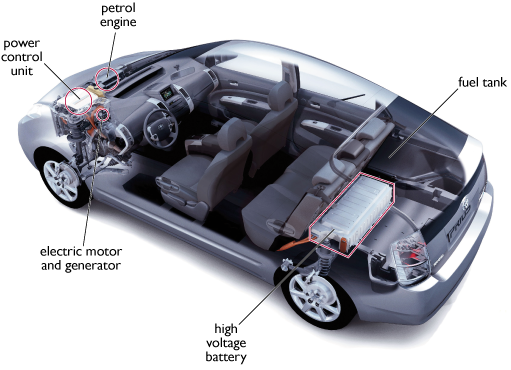5.2 Hybrid vehicles
Drive-train 'hybridization' is a further way to improve the fuel efficiency of ICE vehicles. Petrol–electric hybrids were initially introduced in the late 1990s by Toyota and Honda, and are now offered by several car manufacturers. By February 2011, sales of Toyota's Prius (Figure 7) had reached 3 million worldwide; in the USA, hybrids have around a 3% share of new car sales. By 2012, around a million hybrids were being sold worldwide annually (of which about 15 000 were bought in the UK). With the introduction of many new models, sales are expected to increase significantly over the next few years.

The principle underlying all hybrid vehicles is the use of a rechargeable battery as an energy buffer that enables the main ICE to be operated at close to maximum efficiency. The electric engine is used at low speeds and to assist acceleration – situations when ICEs are least fuel efficient. The battery is charged by the ICE when the engine loading is low. This means that the ICE is used more efficiently and so fuel economy improves. The use of an on-board battery also enables better use of regenerative braking and start/stop than in a conventional petrol or diesel car.
Overall, hybrids reduce fuel consumption through a combination of the following:
- reducing wasted energy during idle/low output, generally by turning off the internal combustion engine
- recapturing waste energy through regenerative braking
- allowing the internal combustion engine to run at greater efficiency by letting the electric motor take over for key engine loadings.
Current models of family hatchback hybrid, such as the Prius and the Lexus CT, have CO2 emissions in the 89–94 g km−1 range. A comparable standard petrol car would have emissions of around 130–160 g km−1, and a diesel around 110–140 g km−1, with 'eco' diesels somewhat less (e.g. the Ford Focus Ecotronic at 99 g km−1). Higher-performance sports saloon hybrids (e.g. the Lexus IS) achieve 135 g km−1, again much lower than a standard petrol or diesel equivalent.
Overall, hybrids cut CO2 emissions by around a third compared with the best equivalent non-hybrid car, and by up to 20% compared with 'eco' diesels. When they were first introduced, hybrid cars did cost more to buy than a diesel or petrol equivalent, but with volume production the price difference has been narrowed.
A development of the hybrid design, that makes less use of the ICE by incorporating the plug-in technology of an all-electric vehicle, will be considered in Section 7.2.
The scope of emission reduction
A limiting factor to reducing CO2 emissions from petrol and diesel cars is the carbon intensity of the fuel used. Whatever is done to improve fuel efficiency, there is a limit set by the fact that petroleum-based fuel is carbon intensive. As already mentioned, in the long term – to 2050 – an 80% reduction in CO2 emissions is being sought. However, the improvements to petrol and diesel cars that have been discussed so far, though substantial, are limited by the chemistry of the fuel itself as well as by the thermodynamic efficiency limits of combustion.
To date, improvements to petrol and diesel car designs and the introduction of hybrid vehicles have put us on a path towards the EU-regulated targets of 130 g km−1 by 2015 and 95 g km−1 by 2020. However, even the best petroleum-based technologies cannot reach the sustainability target we have identified of 20 g km−1 (unless all cars become much smaller, slower and lighter – more akin to a scooter!). The sections that follow will therefore look at some alternatives to petrol and diesel engines.
